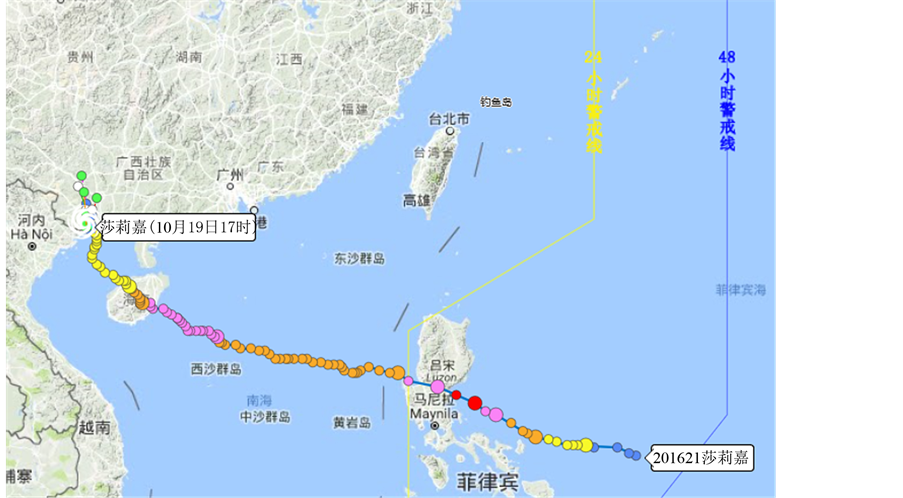1. 引言
热带气旋是指发生在热带洋面上中心气压极低的强气旋性涡流,其强度和路径预警和预测对人们生命和财产安全至关重要,对气旋登录前后强降水和高风速的预警信号准确发布是目前气象领域的重要发展方向。20世纪60年代初,第一颗气象卫星TIROS上天,卫星数据为气象预报和研究人员进行热带气旋监测和预报提供了新的参考源。1975年,Dvorak [1] 提出利用卫星VIS图像估计气旋强度的方法,根据多年经验及统计概括后,形成了利用地球同步卫星的VIS及IR运行估计热带气旋强度的Dvorak技术,且一直沿用至今。Velden等1998年在客观Dvorak技术的基础上,引入了多Dvorak分析规则 [2] ,大大降低了此技术存在的主观性偏差,适用于热带风暴或台风强度的热带气旋,不适用于弱的热带气旋系统。Olander于2007年在算法上有重大改进 [3] ,增加了一些新的云型和眼型类别,修正了一些判别规则,而且更客观和自动化,适用于分析整个热带气旋生命史中的强度变化。
微波数据获得的微波云图资料,因其时间和空间分辨率较低,目前还只是作为Dvorak技术的一种补充手段,应用比较广泛的星载微波载荷包括云雨卫星上的多通道微波扫描辐射仪、美国国防气象卫星上的特种微波成像仪、热带降水测量卫星上的微波成像仪和对地观测卫星上现金的微波扫描辐射计等。其中TRMM卫星 [4] ,采用了非太阳同步轨道,覆盖南北纬40度以内的区域,适用于监测热带地区天气系统,也补充了Dvorak中的一些不足。
2. 我国热带气旋研究现状
Veldon [5] 等人1991年利用MSU资料反演得到的大气温度廓线资料尽力了250 hPa温度距平同气旋中心最低海平面气压和近中心最大风速度的统计回归方程,所得结果同实测强度之间偏差很小,这也预示着利用微波资料估测热带气旋强度的巨大潜力。
AMSU具有更对的遥感通道和更高的空间分辨率,Kidder利用AMSU反演温湿度廓线产品得到热带气旋中心最低海平面气压和梯度层切向风场分布,充分显示出微波探测仪器在热带气旋监测和预报中的应用前景 [6] 。
Spencer和Braswell 2001年利用AMSU得到的6个参数对大西洋区域热带气旋的最大风速进行估计,与观测资料相比,标准偏差仅为4.5 m/s [7] 。
Brueske和Veldon 2003年对AMSU-A观测角度偏差和衍射效应进行修正,利用AMSU-B窗区通道估测气旋眼区尺度,得到更精度的气旋暖核强度 [8] 。
邱红等于2004年利用AMSU-A通道7计算了2001~2003年之间发生在西北太平洋区域热带气旋的暖核亮温距平,同业务部门利用Dvorak技术得到的强度报告值相比,标准偏差为12.1 hPa [9] 。
刘喆等2006年利用AMSU资料反演大气温湿度产品对0414号台风“云娜”进行分析 [10] ,根据相匹配的4时次资料分别估测了该台风在不同阶段的强度,同业务发布的强度报告相比,两者变化趋势一致,平均偏差为11.8 hPa.
3. 在轨实测微波数据在热带气旋监测中的应用
微波数据为FY-3C卫星上搭载的微波湿温探测仪(MWHTS) [11] [12] [13] ,频率覆盖89 GHz~190 GHz,探测通道15个,其中118 GHz观测数据是在极轨对地观测卫星上首次获得,具有重要的研究价值,图1是该仪器实测的通道1 (89 GHz)的亮温资料,可以清晰可见热带气旋移动的移动路径和周围云雨分布。

Figure 1. Brightness temperatures of 89 GHz (MWHTS) in typhoon development process (201621)
图1. 201621号台风发展过程中微波湿度计89 GHz通道观测亮温
热带气旋在发展过程中,眼区上空通常覆盖有卷云,使得主要依靠可见光和红外云图的D技术无法得到其内部信息。相对而言,波长较长的微波毫米波能穿透一定厚度的云层,他能得到气旋内部的辐射信息。
FY-3CMWHTS权重函数和50~60 GHz权重函数分布如图2所示,通道匹配特性如表1所示。其中不同高度不同通道的权重函数具有差异性,因此可以有效探测大气不同高度层的温湿度分布和水成物含量,其中,对应气压250 hpa的通道为118.75 ± 0.8 GHz和54.94 GHz。
热带气旋在发展初期,初始触动出发了洋面上空气的抬升运动,暖湿气流通过潜热释放和感热方式加热上部空气,并逐渐在气旋的中高层形成暖核结构;另一方面,上升运动也使得低层中心气压下降,周围的暖湿气流不断向中心辐合上升,进一步增强其强度。热带气旋统计资料表明,发展成熟的热带气旋暖核中心位于对流层上层250 hpa附近通道,由于在这个高度绝大多数水滴都凝固成冰晶,而冰晶对

Figure 2. Comparison and analysis of weighting functions between MWHTS and MWTS
图2. FY-3C微波湿温探测仪和微波温度计权重函数分析对比

Table 1. Sensitive distribution of oxygen absorption and matching channel
表1. 氧吸收通道高度敏感性分布匹配通道
于微波波段的大气向上微波辐射吸收很小,因此,根据微波垂直探测器所测得的热带气旋在对流层中上层暖核的亮温值,就可以大致估算出热带气旋强度。
微波波段接收到的辐射亮度转化为亮温可表示为 [14] :
 (1)
(1)
其中, 为通道权重函数,
为通道权重函数, 为热带气旋内部温度垂直分布,它隧道气旋中心径向距离r不同而不同,在同一海域,它与气旋环境场气温
为热带气旋内部温度垂直分布,它隧道气旋中心径向距离r不同而不同,在同一海域,它与气旋环境场气温 的关系可近似为:
的关系可近似为:
 (2)
(2)
其中, 是气旋内温度与环境场温度的差异,
是气旋内温度与环境场温度的差异, 表示特定区域这一差异的平均值,
表示特定区域这一差异的平均值, 反映出气旋发展强度的大小,仅与径向距离r相关,并且随气旋不同而存在一定差异。
反映出气旋发展强度的大小,仅与径向距离r相关,并且随气旋不同而存在一定差异。
将公式(2)代入公式(1),并忽略权重函数随温度的微小变化,可得气旋中心亮温
 (3)
(3)
或者: (4)
(4)
其中, 为环境亮温。
为环境亮温。
热带气旋中心区域和最大风圈外的环境场近似满足流体静力平衡条件 [15] 。热带气旋中心气压可以通过静力平衡方程得到,即
 (5)
(5)
其中,Zt为热带气旋尺度范围内50 hpa气层的位势高度,对应的气压为Pt,R为气体常数。
若将(2)代入(5)中,并做泰勒展开,取一阶近似可得
 (6)
(6)
其中,Pse为海表气压。
由公式(4)和(6),消去 ,得到气旋中心表面气压和亮温相对于环境表面气压和亮温的差异关系为:
,得到气旋中心表面气压和亮温相对于环境表面气压和亮温的差异关系为:
 (7)
(7)
其中, ,
, ,
,
 (8)
(8)
系数b同热带气旋所处的环境及所选卫星探测通道的权重函数有关。通过公式(7),可估计热带气旋中心最低海平面气压,在气压差异估算出后,根据梯度风等关系可进一步得到不同径向半径处的表面风速。
利用多个探测通道联合探测,可提高海面气压的反演精度,可根据公式
 (9)
(9)
其中,b1和b2同热带气旋所处的环境及所选卫星探测通道权重函数相关。
风云三号微波湿度计的主要目标是探测大气温湿度垂直分布,探测通道位于水汽和氧气吸收带附近,吸收带的不同位置及吸收函数的差别决定了通道权重函数的峰值高度 [16] [17] 。
根绝MWHTS交轨扫描的特点,考虑暖核水平尺度、形状变化和辐射计扫描角度、衍射效应等因素的影响,设计出一种捕获暖核信息的方法,提高了对热带气旋强度的估算精度。
4. 数值模拟试验设计和WRF模式参数方案
4.1. 区域设置
模式采用两重嵌套网格。试验区域选取西北太平洋热带气旋频发的区域(区域2:109˚E~117˚E,17˚N~21˚N,区域2:109˚E~130˚E,16˚N~24˚N,模式水平分辨率和垂直分辨率相同,均为20.4 km和6.8 km,对应网格格点数分别为105*45和100*46,垂直方向29层,模式顶层气压约为54 hpa。
4.2. 试验数据
本试验主要分析2016年10月14日至19日201621号热带气旋莎莉嘉(Sarika)生成、发展、登录和消亡的整个过程。以NCEP一日4次的FNLgrib2再分析资料作为大气北京场和模式初始边界条件,采用Mercator地图投影,用20.4 km分辨率的模拟结果作为6.8 km分辨率的模拟初始条件,连续积分132小时,每3小时和1小时输出两个嵌套层的模拟结果。
4.3. WRF模式参数化方案
本实验使用的WRF模式为2012年发布的WRF3.4版本 [18] ,经过对不同云微物理过程在不同分辨率下的仿真分析,包括Kessler方案,Lin方案,WSM3 (WRF Single-Moment3)方案,WSM5方案,Eta方案,WSM6方案,WDM5方案和WDM6方案,利用ARTS辐射传输模型进行仿真比对,并与匹配的星载微波观测资料进行交叉比对,结果证明,Kessler方案对暖云降水进行简化,考虑率了水汽的凝结、云水向雨水的自动转换,雨水与云水的碰并、雨水的蒸发,但对于冰和水之间的相变过程进行了忽略。Lin方案参数包括水汽混合比、云水、雨水、云冰、雪和霰(hail),方案较成熟,更适用于高分辨率模拟和理论研究。WSM3方案适用于中尺度网格,参数包括三水、云水或云冰、云水或学,其中云水和云冰计算方法相同,利用温度是否低于或等于凝结点判断云水或云冰的存在,云水和雪也同样计算。WSM5与WSM3类似,与水有关参数包括云水、云、雨水、雪和水汽混合比,在WSM3方案的基础上,考虑冷雨过程中雨和冰、雪和云的交叉碰并过程。Eta方案适应大时间积分步长,考虑云水和水汽的混合比,有利于高精度提取云水、雨、云冰和冻水密度变化的局地信息。WSM6在WSM5基础上增加了霰的信息和相关过程,适用于高分辨率模拟。WDM5 (WRF Double-Moment 5-class)方案在预报水物质混合比的基础上,增加云和雨水浓度和云凝结核数。WDM6方案加强了雷达反射率,增强了强降水活动,削弱了弱降水活动,在分析气溶胶对云和降水过程比较常用。
基于上述分析,本实验最终确定微物理参数MP-Physics设置为6,长波辐射RA-LW-Physics设置为1,短波辐射RA-SW-Physics设置为2。
4.4. 热带气旋区域三维场分析
利用NCEP/WRF模式,得到大气状态数据,利用GRADS画图软件分析三维场,分析大气三维温湿度场的变化,尤其是大气温度剖面信息可用于分析台风中心附近温度异常增长与台风移动路径的关系。进而着重分析压强为250 hpa附近的大气温度和水汽密度,以辅助分析台风暖心,进而为台风路径预测提供参考(见图3)。
5. 星载微波数据和数值模拟联合应用
5.1. 热带气旋路径分析
图4是台风路径实时发布系统发布的2016年10月16~21日21号台风“莎莉嘉”(Sarika)发生、发展、壮大和消亡的过程,本文利用数值模拟和星载微波数据联合对该热带气旋进行定位,确定移动路径,并与发布的路径进行经纬度偏差分析,如表2所示。
双TC相互作用的过程起初相互靠近,通常是反气旋式靠近。然后,经历相互捕捉过程,接着发生长时间互旋,互旋过程中双TC可能相互接近,也可能相互分离,可能的结果有两种,一是其中一种消失,合并到主导台风环流中,而是其中之一从相互影响中迅速远离,实际情况是后者较为普遍。

Figure 4. The process of the occurrence, development, growth and demise of typhoon Sarika on October 16-21, 2016
图4. 2016年10月16-21日21号台风“莎莉嘉”(Sarika)发生、发展、壮大和消亡的过程
表2. 2016年21号台风“莎莉嘉”(Sarika)预测路径偏差分析
海马台风紧跟莎莉嘉台风,两个台风陆续来临。根据历史资料统计经验,当两个以上热带气旋足够近(小于2个纬距)时,会出现逆时针方向的互旋,并存在互相吸引的趋势。在有利的环境流场和其他条件下,双TC可能发生相互旋转、相互吸引和合并、停滞打转等异常运动,通过实时监测和分析可知,这两个台风彼此存在相互影响,但由于莎莉嘉发生在前,大气环流场和内部动力受海马台风影响较小,预报移动路径偏差较小。
结合极轨气象卫星微波湿度计和温度计实测亮温数据和数至模拟数据,针对2016年21号台风进行定位分析,具体见表2。微波数据具有全天候、穿透云雨的特点,是可见光和红外台风定位手段的有效补充。可见,利用数值模拟和卫星微波数据,可以对台风路径作进一步修正。
5.2. 降水分布分析
TC暴雨有三种主要情形:TC由环流内部产生的暴雨,包括螺旋云雨带暴雨、眼壁和中心密蔽云区暴雨;TC低槽产生的暴雨,包括TC倒槽暴雨和气旋北上后的TC槽暴雨;边缘中尺度风暴造成的局部暴雨。成因比较复杂,除必须具备充沛的水汽、强烈的上升运动和较长的持续时间条件外,与TC的强度、路径、登陆后的维持时间和移动速度、热带气旋周围的环境场密切相关。此外,冷空气的侵入,夏季风的爆发与加强以及地形的作用,对暴雨的形成也有重要影响,TC降水的成因主要包括强度、路径、登陆后持续市场年、移动速度、环境场,内部中尺度系统、地形等因素 [19] 。
利用微波数据反演降水 [20] ,根据图5所示的“莎莉嘉”热带气旋过境区域降水分布特征,可知主要降水区分布于热带气旋路径左右两侧偏左或左侧,且随移动路径不同,会发生偏左或偏右的变化。
“莎莉嘉”热带气旋引起的暴雨分布是不对称的,暴雨中心常位于台风路径的左前方或右前方,螺旋云带一般位于台风右半圆。当降水区主要集中在台风前进方向右侧时,凝结加热则有利于台风加速前进,随时路径的推移,降水区主要集中在台风前进方向左侧时,凝结加热作用有利于台风减速前进,台风前进方向并未出现正前方或正后方的降水,因此并未出现台风向左转向或向右转向的情况。
目前极轨气象卫星缺乏足够时间和空间分辨率的降水资料,很难准确辨别出主要降水的确切落区,使得分析降水分布与台风移动的关系有一定困难,很难避免主观成分带来的误差。
6. 微波载荷应用前景
台风年鉴统计,台风路径主要路径有三类 [21] [22] 。第一类:线性路径(即近似直线路径),包括东北行、西北行、偏北行路径,而且整个热带气旋移动路径只截取线性平滑部分,以便与折向型路径的热带气旋的降水中心对比;第二类:左折路径,包括海上折向和登陆后折向;第三类:右折路径,同样分为海上折向和登陆后折向。
根据星载微波数据可确定降水区域及监狱率,进而辅助探测台风路径 [23] 。如果降水区主要是集中在台风前进方向左侧,则凝结加热作用将使台风减速前进:当降水区主要集中在台风前进方向右侧时,凝结加热则会促使台风加速前进。另一方面,台风前进方向正前方的降水有利于台风向左折(转)向;而当主要降水区位于台风正后方时,则凝结加热作用促使台风向右转向。
微波数据对Dvorak技术补充的几个方面:1) 微波图像能识别出热带气旋在形成初期表现出的低层环流中心和低压槽等特征,有助于预报人员更及时准确地判定气旋的生成及在Dvorak技术中所属的云型;2) 微波图像能够得到热带气旋在发展增强阶段眼壁附近的云系结构特征,有助于补充D技术得到与热带气旋强度密切相关的涡度、风切变和对流强度信息;3) 利用D技术通常会对热带气旋的强度变化产生一定滞后,而微波图像能更好地识别出热带气旋强度变化趋势,从而减少了D技术在应用时存在的偏差;4) 处于减弱消亡或变性阶段的热带气旋,由于眼壁附近强对流很快消散,导致D技术只能基于主观性判

Figure 5. Distribution and variation of rainfall rate in northwestern pacific region during the development of typhoon (Sarika, No. 21 in 2016)
图5. 201621号台风莎莉嘉发展过程中西北太平洋区域降雨率的分布及变化规律
断,而利用微波图像能更好的反映地表风场的情况。
7. 结论
尽管搭载于极轨卫星上的微波载荷已经取得了重大进步,但对于路径和强度变化迅速的热带气旋,其时间和空间分辨率较低,微波探测通道的最佳分辨率相对于气旋眼区仍较大,无法完全捕获气旋位于对流层中上层的暖核信息。微波虽然能穿透一定厚度的云层,但对于气旋中低层的强降水而言是完全不透明的,难以得到热带气旋内部详细的结构信息。因此微波探测仪器目前还仅仅是一种对热带气旋监测的补充手段,对于未来的应用具有很大的潜力。
资助项目
中国科协青年托举工程(2015QNRC001),中国科学院青年创新促进会(2016136),军委装备发展部预研基金(6140136010116)。